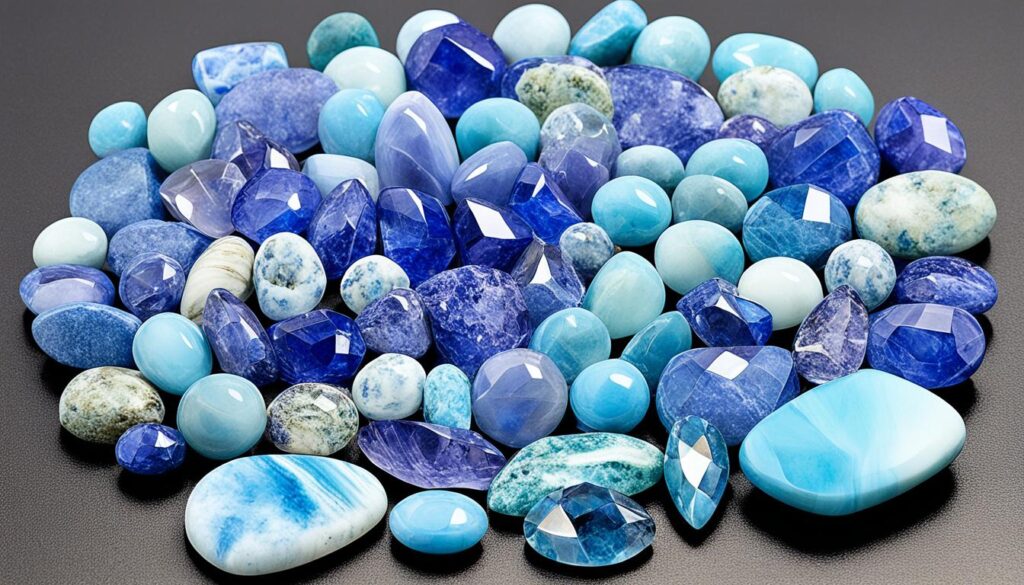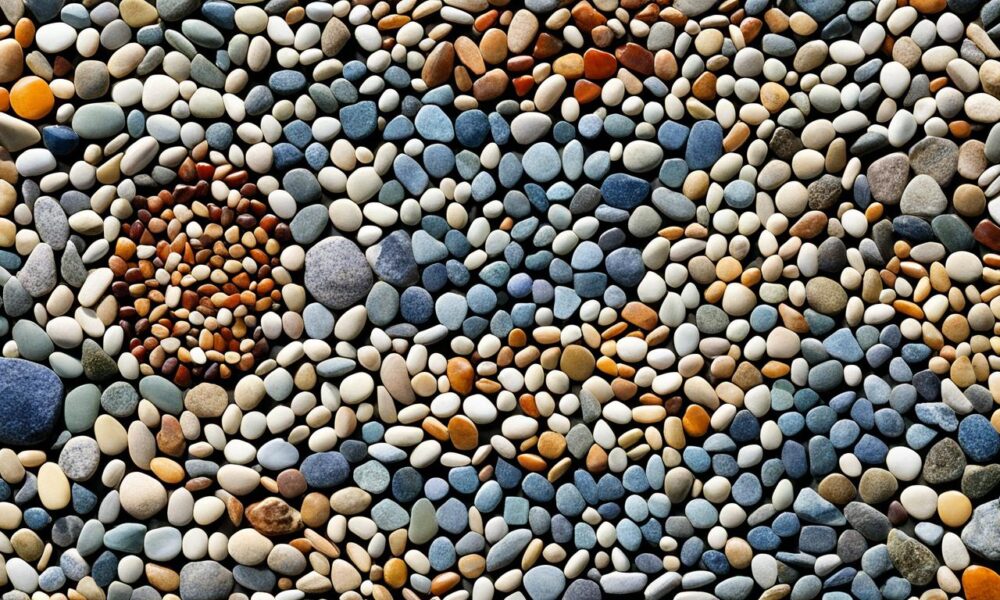Discover Natural Stones Names & Varieties
The Earth harbors a myriad of natural treasures beneath its surface – gemstones with names that whisper tales of ancient myths and untold stories. Each name, often drawn from the Latin or Greek, encapsulates the very essence of the stone’s unique allure, its distinct qualities, and occasionally, the rich history of its discovery. Embark on a journey through a comprehensive A to Z compilation that includes some of the best natural stones, such as the color-changing Alexandrite and the deep, enigmatic Amethyst. Explore an immersive shopping experience that not only provides extensive buying guides but also high-definition videos that capture the very soul of these remarkable wonders.
These earthly jewels, ranging from the most rare natural stones to the widely beloved and unique natural stones, cater to a plethora of tastes. They not only accentuate the extraordinary variety that nature has to offer but also serve as an invaluable guide for connoisseurs and enthusiasts alike. Engage with the splendors that have been meticulously shaped over millennia, and let the legacy of natural stones names guide you to find your perfect piece of Earth’s magnificence.
Key Takeaways
- Discover the meanings behind gemstone names, often rooted in Latin or Greek origins.
- Explore a vast array of the best and most unique natural stones in an A to Z guide.
- Immerse yourself in the shopping experience with extensive guides and high-definition videos.
- Understand the distinguishing traits of rare natural stones for informed selections.
- Utilize the encyclopedic variety of natural stones names to find your precious gem.
Understanding Natural Stones: An Overview
From the opulence of palatial estates to the personal elegance of fine jewelry, natural stones have been an essential part of human culture and design. These elements of the Earth are as varied in their application as they are in their formation, serving both functional and ornamental purposes. With a wealth of characteristics, types of natural stones, such as minerals, organic stones, and rocks, not only define the field of geology but also enrich our daily lives in the form of natural stones for countertops and natural stones for landscaping.
Definition and Importance of Natural Stones
Natural stones comprise a vast family of minerals, each distinguished by their unique chemical compositions, colors, lusters, and hardness levels. The term ‘natural stones’ encompasses not only these crystalline beauties but also includes the organic derivatives like pearls and amber, as well as the agglomerates of minerals forming various rocks. Revered for their durability and aesthetic appeal, these stones play a pivotal role in architecture, interior design, and fashion.
Historical Significance of Natural Stones
Delving into history, natural stones have laid the foundation of monumental architecture and have glistened on crowns and necklines with a silent yet potent language of prestige. Gems like Rubies and Diamonds have bedazzled the thrones and scepters of royals, asserting the blend of beauty with power. It is this storied past that continues to endow natural stones with a sense of timelessness and cultural significance.
The ancient Egyptians lined their vast pyramids with granite, while Romans paved their expansive empire with cobblestones and marble. Each stone, semi-precious or not, contributes its unmistakable beauty and resilience to the story of civilization. The journey of these stones from the heart of the earth to mankind’s greatest treasures is a testament to their everlasting allure.
Popular Natural Stones for Jewelry Making
The very essence of high-end jewelry design lies in its use of exquisite natural stones, each handpicked for its radiance and significance. No ornament is complete without the incorporation of popular natural stones that act not only as embellishments but as the centerpiece of attraction. As we delve into the alluring world of these precious elements, we look at the classics revered for their unmatched beauty and the vibrant array of semi-precious alternatives enriching the natural stones list for jewelry making.
The Allure of Diamonds and Rubies
When it comes to fine jewelry, Diamonds stand atop the hierarchy with their unparalleled sparkle and timeless appeal. Famed for being a girl’s best friend, these crystalline marvels symbolize enduring love and commitment. Similarly, the fiery allure of Rubies captures hearts with their deep red hue, often associated with passion and prosperity. These gems serve not only as luxurious adornments but also investment pieces, their rarity affirming their position in the apex of precious stones.
Sapphires, Emeralds, and Semi-Precious Alternatives
Sapphires and Emeralds paint jewelry with strokes of vibrant colors—from the tranquil blues of the former to the rich greens of the latter. Each holds a cherished spot in the realm of popular natural stones for jewelry crafting. Yet beyond these stalwarts, a plethora of semi-precious stones beckon with their diverse colors and textures. Let’s take a visual journey through some of the most celebrated semi-precious stones used in contemporary jewelry.
| Gemstone | Description | Color Palette | Popular Use |
|---|---|---|---|
| Amethyst | Quartz variety with a regal purple shade | Variants from lilac to deep violet | Necklaces and engagement rings |
| Aquamarine | Famed for its clear blue to sea-green colors | Watery hues capturing the essence of the ocean | Elegant pendants and drop earrings |
| Citrine | Quartz with a joyful, sun-kissed glow | Warm yellows to reddish-browns | Cocktail rings and statement bracelets |
| Garnet | Deep red to purple, known for its rich saturation | Classic red to exotic green varieties | Brooches and vintage-inspired jewelry |
| Peridot | Olive-green gem that embodies summer’s warmth | Lush green, often with golden undertones | Solitaire rings and layered necklaces |
| Turquoise | Historical stone with a distinctive sky-blue color | Unique blue-green spectrum speckled with veins | Bohemian jewelry and artisanal crafts |
The allure of these stones lies in their fascinating color stories and the creativity they inspire in jewelry designs. Each semi-precious gem is handcrafted into pieces that resonate with personal style while offering a spectrum of hues to complement any wardrobe. As we continue to explore the natural stones list, it’s evident that the world of jewelry is infinitely enriched by the diversity and charm of these earthly wonders.
Natural Stones Names in Architecture
The annals of history are etched with the grandeur of architectural masterpieces, a grandeur owed significantly to the natural stones that form their very essence. As we explore the indelible mark of natural stones in architecture, we unveil the timeless charm and robust functionality of these materials that not only serve as the backbone of construction but also as keystones of aesthetic appeal and lasting endurance.
Majestic Marbles and Limestones
Marble has long stood as the epitome of luxury and timeless elegance in structures that span from ancient temples to modern-day skyscrapers. Its range of patterns and ability to reflect light elegantly epitomize sophistication. Limestone, akin to marble in its natural beauty, complements the architect’s pallet with its earthy tones and textural depth. These stones have been hewn, carved, and polished to reveal their delicate veining and vibrant array of colors, gracing the façades and interiors of civilization’s most enduring edifices.
Granite, Slate, and Sandstone in Construction
The rugged strength of Granite makes it an ideal contender for construction purposes, bearing the weight of years with undeniable resilience. A favorite for countertops and outdoor cladding, this stone intersects functionality with its natural, granulated beauty. Slate’s density and durability make it a prime choice for roofing and flooring, its fine grain and matte finish casting a stately allure. Sandstone, with its sandy matrix, stands as a testament to time, its warm hues blending seamlessly in both historical restorations and modern architectural applications. Each of these stones embodies the harmonious blend of nature’s artistry with human ingenuity.
- Marble—the hallmark of opulence in palaces and monuments
- Limestone—an aesthetic choice for subtle architectural grace
- Granite—a staple for long-lasting and resilient structures
- Slate—the definitive selection for protective and decorative finishes
- Sandstone—a picturesque medium for crafting heritage and tradition
As proponents of sustainable and majestic constructions, natural stones like Marble, Limestone, Granite, Slate, and Sandstone continue to dominate the scene in both their natural and refined glory. The infinite variety of patterns, the uniqueness of each piece, the environmental friendliness, and the inherent durability make natural stones the quintessential element for those who seek to embed their edifices with the heart of nature’s purest expressions.
Exquisite and Rare Natural Stones
The realm of gemstones boasts an endless spectrum of color and light, with some exhibiting such allure they are deemed treasures among the rarest finds in the world. Captivating collectors and jewelry aficionados alike, these stones are not only beautiful but tell tales of remote origins and mysterious formations. Within this exclusive enclave of precious stones are gems such as Tanzanite and Larimar – stones of such rarity and mesmerizing beauty that they inspire a legendary status among the exquisite natural stones of the world.
Discovering Tanzanite and Larimar
The discovery of Tanzanite, a gem with a velvety blue-purple hue found only in the Mererani Hills of Tanzania, was as recent as the 1960s. The stone’s singularity in location makes it one of the most rare natural stones on the planet. So exclusive is Tanzanite that experts predict its mines will be depleted within a generation, making it an irreplaceable jewel in the crown of gemstone collections.
Sharing a similar fate of rarity, Larimar – found only in the Dominican Republic – enchants with its soothing shades of blue and green that mirror the Caribbean Sea. Known as the Atlantis Stone, Larimar’s swirling patterns offer a visual symphony of oceanic colors that evoke the beauty of tropical waters.

The Unique Appeal of Moonstone and Sunstone
Another duo that captivates with a play of light and shadow are Moonstone and Sunstone. Moonstone, beloved for its ethereal glow, is treasured across cultures for its enchanting ‘adularescence’ – the soft light that dances across the stone much like moonlight over water. Associated with lunar mystery, this gem has featured in art and jewelry since ancient times.
Sunstone, in contrast, sparkles with a fiery brilliance known as ‘aventurescence’. This mineral’s shimmering effect, akin to reflections off the sun-dappled waters of a serene lake at dawn, is due to inclusions of hematite or goethite within the stone. As its name suggests, Sunstone embodies the energy and radiance of the sun, making it a compelling choice for those seeking the warmth and vigor in their jeweled pieces. The charming luminescence of both Moonstone and Sunstone brings a unique charisma that is as distinctive as it is dramatic.
| Stone | Color | Rarity | Unique Feature |
|---|---|---|---|
| Tanzanite | Blue to Purple | Extremely Rare | Geological Singularity |
| Larimar | Blue to Green | Uniquely Located | Oceanic Patterns |
| Moonstone | Colorless to White, Shades of Peach and Blue | Rare in Blue | Adularescence |
| Sunstone | Yellow to Red-Brown | Varies | Aventurescence |
Whether set in the finest of settings or collected as singular natural wonders, the tales of Tanzanite, Larimar, Moonstone, and Sunstone are woven deeply into the tapestry of gemstone lore. Their rarity and beauty continue to enchant and ignite the imagination, securing their place in the pantheon of exquisite natural stones.
Natural Stones Used in Astrology and Healing
Ancient wisdom and modern practices often intersect in the harmonious use of natural stones for healing and astrological purposes. These stones are not merely ornamental; they are believed to possess powers that can influence the energy fields of the human body, bringing balance, wellness, and alignment with cosmic vibrations. The following is an exploration of astrological gemstones and healing gemstones, emphasizing their reputed properties and uses in various cultural and spiritual healing practices.
Take, for instance, the radiant Ruby, often associated with the Sun in many astrological systems. This precious stone is believed to imbue the wearer with vitality, courage, and the passion for life. Similarly, the Moonstone, with its milky luster, is aligned with the moon’s energies, purportedly offering intuition and a sense of calm to those it graces. These stones, like many others, hold a special place in the realms of both healing and astrology.
On the more mystical side of the gemstone spectrum, we encounter the enigmatic Spinel and the glassy green Moldavite. Spinel, available in a range of colors, is said to be a stone of revitalization, helping to clear out stress and replenish dwindling energy reserves. Moldavite, a result of a meteorite’s violent impact with Earth, is often used in healing circles to accelerate spiritual growth and increase the wearer’s vibrational frequency.
Many practitioners incorporate these gemstones into their healing modalities by placing them on corresponding chakras, the energy centers of the body. Chakra alignment with the appropriate stones is said to facilitate physical, emotional, and spiritual healing, addressing issues from the base of the spine to the crown of the head.
| Stone | Chakra | Healing Properties | Astrological Significance |
|---|---|---|---|
| Ruby | Root/Base | Strength, Vitality | Sun – Leadership, Confidence |
| Moonstone | Sacral/Third Eye | Calming, Intuition | Moon – Emotions, Inner Peace |
| Spinel | Multiple Chakras | Energizing, Balancing | – |
| Moldavite | Heart/Third Eye/Crown | Transformation, Healing | – |
The selection of gemstones for healing and astrological applications extends far beyond just beauty or rarity. Each stone’s perceived attributes contribute to the multi-faceted approach people take towards mental and physical well-being. Whether embraced for their spiritual significance or their earthy splendor, these gems serve as tools for those seeking a greater harmony within the universe and themselves.
How to Choose the Right Natural Stones for You
Embarking on the journey of choosing natural stones can be as thrilling as unearthing hidden treasures, whether it’s for personal adornment, healing, or enhancing the cosmic connection through astrology. Armed with a dash of knowledge and an eye for detail, anyone can navigate the multifaceted world of gemstones. Let this guide illuminate the path to making a quality selection of gemstones that resonate with your personal narrative and intended use.
The allure of a gemstone often begins with its color. Each hue speaks to the beholder, evoking emotions or signifying an aspect of their persona. Delve into the seemingly endless palette, from the passionate reds of Rubies to the tranquil blues of Sapphires, considering how the stone’s color aligns with your style or the energy you seek to invite into your life.
Equally important is clarity, another critical component of a gemstone’s allure. Clarity dictates the stone’s purity and can range from the flawlessness of a Diamond to stones like Emeralds, where inclusions are embraced as a unique fingerprint. Incorporating gemstones with unique inclusions can add character and distinction, often making the piece exclusive to its wearer.

As we sift through nature’s offerings, the cut of the stone also demands our attention. Beyond traditional round brilliants or emerald cuts lies a universe of creativity. From the innovative princess cut to the vintage allure of a cabochon, each gemstone cut conjures different dimensions of light and depth, which can drastically alter the stone’s visual impact.
Consider also the provenance of your chosen gem. Much like a rare vintage wine, the origin of a stone can speak volumes about its pedigree, with certain locations synonymous with high quality and prestige. It isn’t just about aesthetics but about the story that comes with the gem—a narrative that catches the collector’s fancy and adds an invisible layer of value.
Lastly, rarity should not escape your scrutiny. A gemstone’s exclusivity can imbue the owner with a sense of pride, much like holding a fragment of history. The rare natural stones often carry within them, the whispers of the earth’s untold epochs, rendering them not just ornaments but keepsakes for generations to cherish.
Aligning with your intentions is of paramount importance, no matter the route you take in selecting your stone. Whether it’s to dazzle with aesthetics or to fulfill deeper spiritual purposes, honoring your individuality is crucial in this quest. For those who heed the call, here awaits a tableau of options, each more tempting than the next:
| Intention | Recommended Gemstone | Notable Attributes |
|---|---|---|
| Personal Expression | Ruby | Vibrant hue, symbolizes love and vitality |
| Spiritual Enlightenment | Lapis Lazuli | Deep blue with golden flecks, associated with wisdom |
| Astrological Harmony | Yellow Sapphire | Lustrous brilliance, linked to benevolence and fortune |
| Healing and Wellness | Amethyst | Soothing purple tones, known for tranquility |
Choosing the right natural stone can be a journey filled with wonder, self-discovery, and connection to the earth’s ancient resources. Listen to the stories each stone tells, feel the energy they exude, and find the one that truly speaks the language of your soul.
Natural Stones Names and Their Geographic Origins
The connection between natural stones and their places of origin is not only a matter of history and geology but also of immense value to gemstone enthusiasts and collectors. Understanding the gemstone geographic origins can offer profound insights into their uniqueness and rarity, elements that are intricately woven into the narrative of each stone. These origins form a tapestry of stories that enhance the desirability and mystique of natural stones in the global market.
Famous Mining Regions for Precious Stones
Precious stones like Sapphires, Emeralds, and Diamonds are often accompanied by tales of adventure and discovery. Sapphires, resplendent in their blue depths, are predominantly mined in the lush landscapes of Kashmir, Sri Lanka, and Madagascar. Emeralds, with their verdant hues, claim their most prized origins from the Colombian mines, while the scintillating Diamonds have been historically unearthed in the rich soils of South Africa, as well as in the frosty expanses of Russia and the bustling markets of Antwerp. These mining regions for natural stones are celebrated not just for their output but for their unique contribution to the stone’s narrative and character.
Understanding the Impact of Origin on Stone Value
The provenance of a natural stone often plays a critical role in determining its value and collector’s appeal. A Kashmir Sapphire, for example, commands a premium, not only for its exceptional quality but also for the region’s historical significance in the gem trade. In a similar vein, Colombian Emeralds are treasured for their unparalleled vibrancy and clarity which is almost synonymous with the nation itself. The geographic origin of these gems adds layers of cultural and economic significance, making each piece a living mosaic of its native earth. Collectors and connoisseurs thus consider the origin as a fundamental aspect when valuing and trading in these exquisite gifts from nature’s vast riches.
Conclusion
In delving into the vast expanse of best natural stones, we have traversed a path rich with history, artistry, and deep cultural significance. These stones, products of the Earth’s relentless artisanship, range from the widely known types of natural stones such as the beguiling Sapphire and the resplendent Emerald, to the mystical Alexandrite and the tranquil Amethyst. Their names – evocative of the romance and mystery that they carry – transcend mere labels to become storied emblems of nature’s creativity.
Whether gracing the halls of ancient architecture, adorning the delicate touchpoints of jewelry, or serving as conduits of holistic wellbeing in astrology and healing, natural stones offer a lens through which we can view our world with a more profound appreciation. Natural stones names invoke curiosity and wonder, leading many to explore their significance, embrace their beauty, and delve into their storied origins.
As our exploration concludes, it is evident that natural stones hold a mirror to the past while offering enchanting prospects for the future. Their allure remains undiminished, enchanting collectors, crafters, and seekers of the metaphysical alike. From investment to embellishment to personal growth, understanding the full scope of natural stones enriches our interactions with the very elements that the Earth bestows upon us. Indeed, the world of natural stones is as infinite as it is fascinating, providing a kaleidoscope of hues, shapes, and energies that continue to captivate and inspire.



